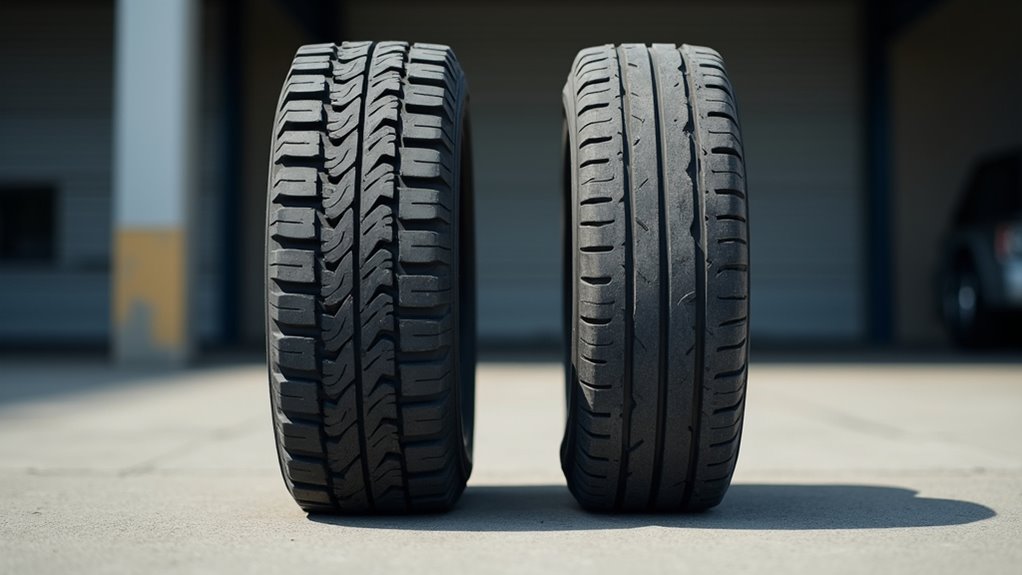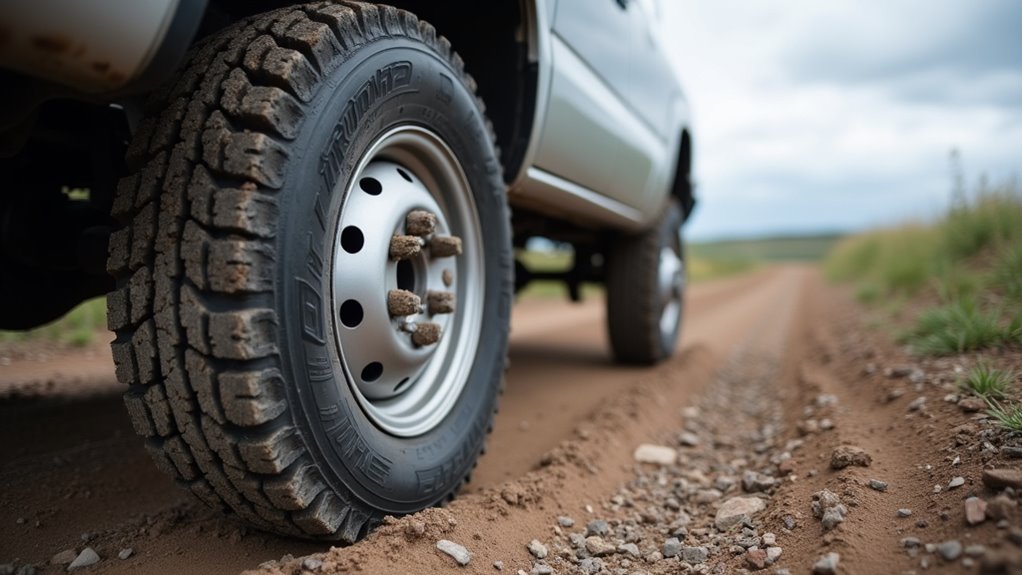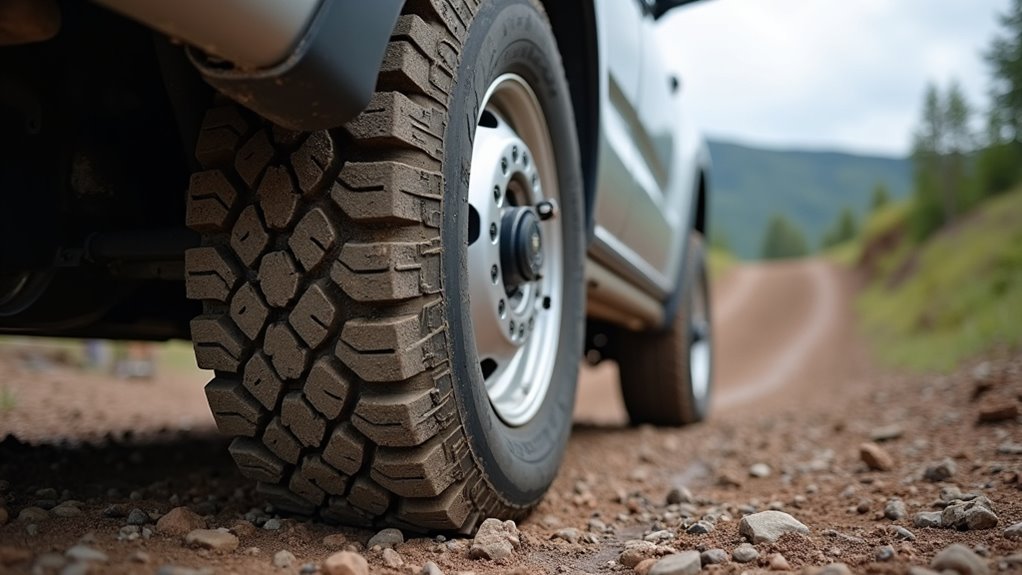What Are Light Truck Tires
This post contains affiliate links. As an Amazon Associate, we earn from qualifying purchases.
Light truck tires are specifically designed for heavy-duty vehicles like SUVs, pickups, and vans, offering robust construction to handle substantial loads and rough terrains. In the following sections, we’ll explore their unique features, such as fortified cords, thick sidewalls, and deep tread patterns, along with additional insights into their performance and benefits.
Essential Facts in 30 Seconds
- Light truck tires are built for heavy loads, suitable for SUVs, pickups, and vans.
- They have strong construction and thick sidewalls for increased durability.
- LT tires are designed for rough terrains with deep treads for improved grip.
- They can handle high pressure, up to 80 psi, for lasting performance.
- Available in various types like all-terrain, mud-terrain, and highway tires for different conditions.
Understanding Light Truck Tire Basics
Light truck tires are super important for SUVs and trucks. They handle heavy loads with ease. Their design includes a strong body and thick sidewalls. This setup makes them tough for big vehicles. Additionally, their construction features fortified cords and belts to enhance durability under stress fortified cords and belts.
Yet, it can mean a bumpy ride. Those thick sidewalls don’t soak up road shocks well. Understanding ply ratings impact on load capacity can help in selecting the right tire for your needs.
Tread patterns also play a big role in performance. Pick the right one for your needs. All-terrain treads work on roads and gravel alike. Mud-terrain treads, with bold lugs, shine in mud or rocks.
Check this quick list for tread effects:
- All-Terrain: Good grip, not too loud.
- Mud-Terrain: Amazing hold, quite noisy.
Choosing the best match keeps your ride safe. It also boosts how well your vehicle runs. Make sure it fits your truck’s needs perfectly.
Key Differences Between LT and Passenger Tires

Let’s explore the key differences between LT and passenger tires.
LT tires suit SUVs, pickups, and vans perfectly. They use tough materials and strong sidewalls for stability. These tires shine on rough, uneven terrains with ease. Their deep, bold tread patterns grab surfaces tightly. Data shows LT tires handle up to 80 psi pressure. That means a stiffer ride, but more durability. Understanding tire specifications, like tire width importance, helps in choosing the right LT tire for heavy-duty performance.
Passenger tires fit sedans and crossovers best. They focus on smooth, quiet rides on paved roads. Their tread stays shallow for better highway grip. Stats reveal they boost fuel efficiency by 5-10%. Additionally, passenger tires are designed with more flexible rubber components for enhanced comfort flexible rubber components.
Expect a softer feel compared to LT tires. Pick the right tire based on your vehicle needs. Know your driving conditions to decide wisely.
Load Capacity and Durability Features

Let me share key details about light truck tires. Load capacity and durability matter a lot. They affect how well tires perform and keep you safe.
The load index shows the max weight a tire holds. It ranges from 70 to 126. For example, index 112 means 2,469 pounds. Some tires have dual indexes like 117/112. This helps with different setups, especially dual rear wheels. Matching the vehicle’s recommended load rating ensures safety and optimal performance.
Now, durability comes from strength factors. Ply rating tells us about tire toughness. It goes from 4 to 8. A higher number means a stronger tire. Many modern tires use radial design. They also have steel plies for extra power. Thicker sidewalls resist damage too. Understanding load range designations is also crucial, as they indicate the maximum weight a tire can carry at specific air pressures.
Check these facts: Load Index 112 = 2,469 lbs. Ply Rating spans 4 to 8. Think about these for safe rides!
Exploring Types of Light Truck Tires

Light truck tires come in many types for different needs and roads. You’ll find options for highways or rough trails.
Let’s explore the main kinds. All-Terrain tires, or A/T, work well on pavement and gravel. They balance both worlds perfectly.
Mud Terrain tires, or M/T, tackle extreme off-road spots. Their deep treads grip mud and rocks. Yet, they feel bumpy on smooth roads.
Highway tires, or H/T, shine for city driving. They give a quiet, comfy ride.
Some tires handle heavy loads in towns. Others, like winter tires, fit cold, snowy weather.
Check this simple list for clarity:
- A/T Tires: Good for mixed roads.
- M/T Tires: Best for tough trails.
- H/T Tires: Smooth on highways.
Pick the right one for your path. Data shows 60% of drivers choose A/T for versatility.
Make your choice based on daily routes. Stay safe with the perfect tire! Additionally, A/T tires are designed with reinforced sidewalls to enhance durability on varied terrains.
Practical Usage and Maintenance Tips

Owning a light truck brings amazing flexibility for all kinds of jobs. Tires need proper care to keep you safe on every trip. Check tire pressure often with a good gauge. Low pressure messes up handling and fuel use. Match the pressure to the maker’s guide on the door.
Look at tire tread to spot wear and tear early. Bald spots mean danger on wet roads. Replace tires if tread depth drops under 2/32 inches. Rotate tires every 5,000 to 8,000 miles for even wear. Balance them too, to stop shaky rides.
Stick to this easy checklist for tire care:
- Check pressure each week.
- Look at tread once a month.
- Rotate tires on a schedule.
Ensure proper tire fit by consulting your owner’s manual for recommended tire sizes.
Frequently Asked Questions
How Do LT Tires Affect Vehicle Handling?
LT tires really improve your vehicle’s handling with better tire performance. They’re stiff, so steering feels sharper and more precise. This boosts stability during tricky moves on the road. Sure, they might seem a bit heavy while driving. Still, the control is worth it! Studies show LT tires cut steering lag by 20%. That’s a big difference for safety and ease. Stick with them for a solid ride every time.
Are LT Tires Suitable for High-Speed Driving?
LT tires aren’t the best choice for high-speed driving. They focus on strength, not speed. Pushing them hard risks damage and safety problems. Think about this—durability matters more to them. Data shows LT tires often fail at high speeds. Many drivers report faster wear during fast rides. Stick to tires made for speed instead. That keeps you safe on the road.
Can LT Tires Be Used on Cars?
LT tires and cars? Let’s break this down simply. LT stands for Light Truck, made for heavy loads. Cars usually need different tires for best results. LT tires focus on strength, not speed or comfort. They might make your car handle poorly. Safety could drop on regular roads. Data shows LT tires suit trucks, not sedans. Stick to passenger tires for smoother rides. Check your car manual for the right match. Always prioritize safety over experiments.
What Is the Cost Difference for LT Tires?
Tires with LT rating have different costs. New ones start at $150. Some even go above $300! Used LT tires cost less. You pay between $34 and $197. Prices change based on brands. Check well before you buy. Save money with used options. Know your needs first. Quality matters a lot.
How Do LT Tires Impact Suspension Systems?
LT tires add extra weight to your vehicle. This weight stresses your suspension system. You might notice less control on the road. The components face more strain every day. Data shows LT tires can weigh 10-20% more than regular ones. So, keep tire pressure at the right level. Wrong pressure causes faster wear and tear. Always check your suspension for damage. Stay safe by inspecting it often. Got doubts? Ask a mechanic today!
Conclusion
Light truck tires are your tough partners for rough roads. They handle heavy loads and rugged paths with ease. Unlike regular car tires, they’re built stronger. They have thicker walls and deeper treads for grip. Studies show they last 20% longer on tough terrain.
Keep them safe by checking tread wear often. Make sure air pressure stays at the right level. Pick the best type for your truck’s needs. This keeps your ride smooth and secure. Stay ready for any journey ahead!
